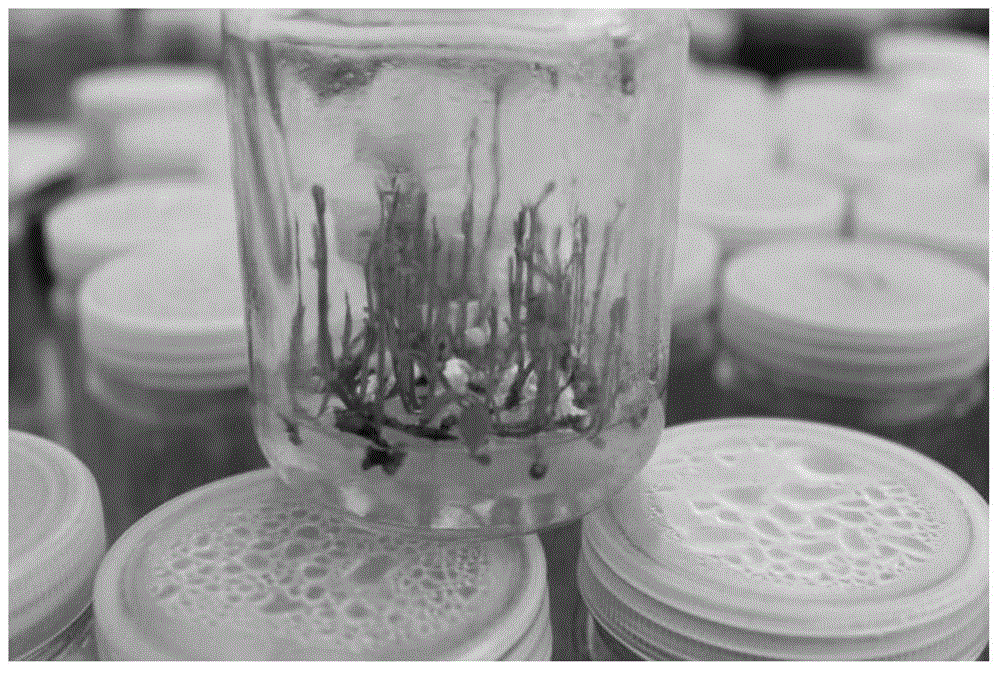The Group Breeding Method of Guangdong Twig Bean
A technology of twig bean and seedling hardening, which is applied in the fields of agricultural biology and applied biology, can solve the problems of few twig seeds and restrict production development, and achieve a short seedling cycle, stable and reliable results, and low requirements for experimental facilities Effect
- Summary
- Abstract
- Description
- Claims
- Application Information
AI Technical Summary
Problems solved by technology
Method used
Image
Examples
Embodiment 1
[0046](1) Seed disinfection and germination: The seeds of Millettia fordii Dunn (Millettia fordii Dunn) in Guangdong were purchased from Guangzhou Dayou Yuxuan Agricultural Development Co., Ltd; On the clean workbench; pour 75% alcohol into the disinfection bottle, shake it left and right, disinfect it for 8 minutes, and rinse it twice with sterile water; then pour 1g / L mercuric chloride for disinfection for 4 minutes, and finally rinse it with sterile water for 4 minutes. times; placed in sterile moist gauze, covered with gauze seeds. The pollution-free rate of seeds after disinfection can reach 70.6%.
[0047] (2) Select explant: 15 days after seed inoculation, begin to germinate; In 30 days, germinate grows to 3cm high, select the healthy and strong germ bar that does not pollute, after cutting off radicle and cotyledon, get hypocotyl as explant. The total germination rate reached 85.0%.
[0048] (3) Proliferation of adventitious buds: the explants obtained in step (2) we...
Embodiment 2
[0052] (1) Seed disinfection and germination: The seeds of Millettia fordii Dunn (Millettia fordii Dunn) in Guangdong were purchased from Guangzhou Dayou Yuxuan Agricultural Development Co., Ltd; On the clean workbench; pour 75% alcohol into the disinfection bottle, shake it left and right, disinfect it for 12 minutes, and rinse it twice with sterile water; then pour 1g / L mercuric chloride for disinfection for 6 minutes, and finally rinse it with sterile water for 4 minutes times; placed in sterile moist gauze, covered with gauze seeds. The pollution-free rate of seeds after disinfection can reach 73%.
[0053] (2) Select explant: 15 days after seed inoculation, begin to germinate; In 30 days, germinate grows to 3cm high, select the healthy and strong germ bar that does not pollute, after cutting off radicle and cotyledon, get hypocotyl as explant. The total germination rate reached 85.2%.
[0054] (3) Proliferation of adventitious buds: the explants obtained in step (2) wer...
Embodiment 3
[0058] (1) Seed disinfection and germination: The seeds of Millettia fordii Dunn (Millettia fordii Dunn) in Guangdong were purchased from Guangzhou Dayou Yuxuan Agricultural Development Co., Ltd; On the clean workbench; pour 75% alcohol into the disinfection bottle, shake it left and right, disinfect it for 15 minutes, and rinse it twice with sterile water; then pour 1g / L mercuric chloride for disinfection for 8 minutes, and finally rinse it with sterile water for 4 minutes. times; placed in sterile moist gauze, covered with gauze seeds. The pollution-free rate of seeds after disinfection can reach 90%.
[0059] (2) Select explant: 15 days after seed inoculation, begin to germinate; In 30 days, germinate grows to 3cm high, select the healthy and strong germ bar that does not pollute, after cutting off radicle and cotyledon, get hypocotyl as explant. The total germination rate is 86%.
[0060] (3) Proliferation of adventitious buds: the explants obtained in step (2) were inoc...
PUM
 Login to View More
Login to View More Abstract
Description
Claims
Application Information
 Login to View More
Login to View More - R&D
- Intellectual Property
- Life Sciences
- Materials
- Tech Scout
- Unparalleled Data Quality
- Higher Quality Content
- 60% Fewer Hallucinations
Browse by: Latest US Patents, China's latest patents, Technical Efficacy Thesaurus, Application Domain, Technology Topic, Popular Technical Reports.
© 2025 PatSnap. All rights reserved.Legal|Privacy policy|Modern Slavery Act Transparency Statement|Sitemap|About US| Contact US: help@patsnap.com



